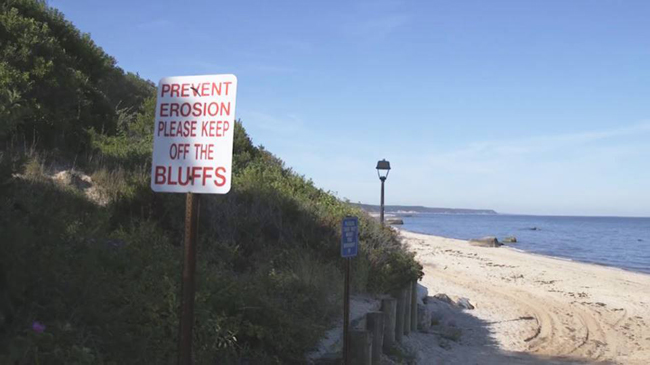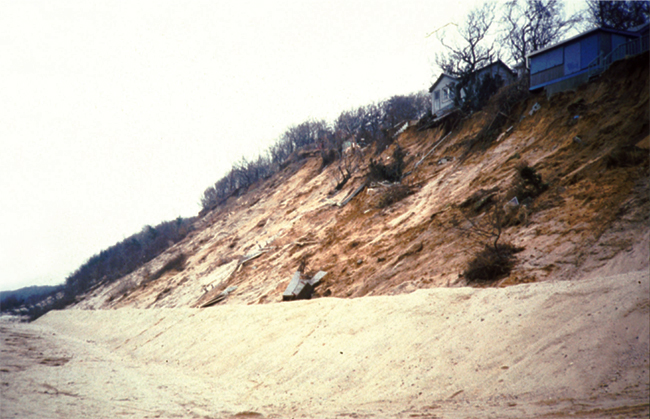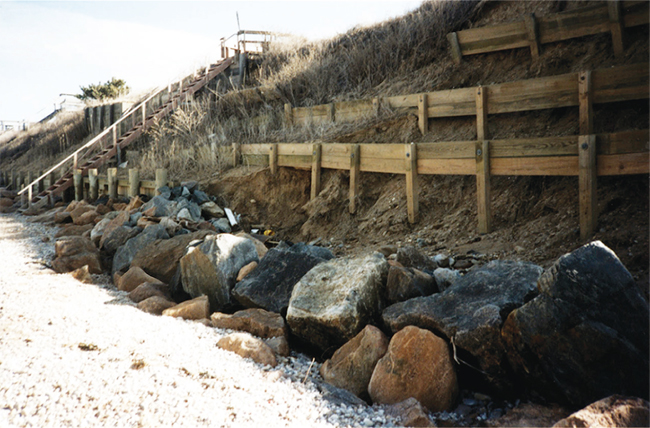
When people walk on bluffs, they risk trampling plants and/or loosening sand in the face. Credit: Cornell Extension Marine Program
Contacts:
Kathleen Fallon, Coastal Processes & Hazards Specialist, NYSG, E: kmf228@cornell.edu, P: (631) 632-8730
New York, NY, March 19, 2018 – Kathleen Fallon, the Coastal Processes & Hazards Specialist for New York Sea Grant (NYSG), has created a four page fact sheet about coastal erosion on Long Island. Erosion affects coastal communities on all across Long Island, from the Hamptons on the South Fork to North Shore communities along the Long Island Sound.
Fallon works closely with other organizations, elected officials, and researchers at Stony Brook University to provide the public with information and insights on erosion management. A key to her success: conversations with community members about the erosion mitigation options available to them. Fallon also serves as a resource for information on rip currents, coastal storms, sea level rise, and flooding, among other processes.
“I am fascinated by the movement of sediment on beaches,” said Fallon, in an earlier article from NYSG. “This usually means either long-term or temporary erosion events. I have witnessed many times when a local community might not fully understand what is happening to their shore. I look forward to being the person that someone who has concerns can turn to for understanding.”

Kathleen Fallon, NYSG's Marine District Coastal Processes and Hazards Specialist
Her latest project, to provide Long Island’s coastal landowners with resources, speaks to the variety of erosion problems affecting the region’s communities.
“The North Shore of Long Island has bluffs. Many homes are built near the edge of these bluffs, so community members are concerned about the ground slumping and falling away,” said Fallon. “On the South Shore, people tend to be more concerned with beach erosion. Here, many communities are protected by Fire Island, which acts as a barrier and takes on the brunt of erosion-causing waves. However, communities on Fire Island as well as in the Hamptons are directly impacted by these destructive waves.”
The fact sheet is designed to help landowners identify and understand the primary causes and processes responsible for their erosion issues. With a general understanding of these causes and processes, an owner can move forward with the appropriate professional assistance and effectively deal with the specific erosion problem they have encountered. The fact sheet contains information relating to storm damage, dune erosion, bluff erosion, and sea level rise.
“Coastal erosion processes on Long Island can be complicated,” Fallon writes in the fact sheet. “Therefore, before attempting to solve the erosion problem, it is important for landowners to identify the main cause of their erosion issue. A quick fix might result in a greater issue down the line. A better understanding of erosion processes will result in selection of the right solution.”

Top photo: This bluff is eroding; the face is unvegetated and slumping. As a result, the houses on top are in danger of sliding off unless immediate action is taken. Bottom photo: This bluff is stabilized by terracing the slope and installing a rock revetment at the toe. Credit: Jay Tanski

The fact sheet comes at a particularly relevant time for beach erosion. Each of this winter season’s nor’easters and coastal flood warnings have been accompanied with beach erosion. By the time the summer season arrives, the impacts of winter storms will be visible to Long Islanders returning to the beach.
Fallon earned her B.S. in Marine Sciences from Stony Brook University in 2012 and completed her Ph.D. in Geosciences from Florida International University in 2017. Her dissertation explored the formation of rip currents and the implications these potentially fatal currents have for beachgoers. In her study, Fallon incorporated the physical science of the coast, while also collaborating with social scientists to bring her research to the shore.
More Info: New York Sea Grant
New York Sea Grant (NYSG), a cooperative program of Cornell University
and the State University of New York (SUNY), is one of 33 university-based
programs under the National Oceanic and Atmospheric Administration’s
National Sea Grant College Program.
Since 1971, NYSG has represented a statewide network of integrated
research, education and extension services promoting coastal community
economic vitality, environmental sustainability and citizen awareness
and understanding about the State’s marine and Great Lakes resources.
Through NYSG’s efforts, the combined talents of university scientists
and extension specialists help develop and transfer science-based
information to many coastal user groups—businesses and industries,
federal, state and local government decision-makers and agency managers,
educators, the media and the interested public.
The program maintains Great Lakes offices at Cornell University, SUNY
Buffalo, SUNY Oswego and the Wayne County Cooperative Extension office
in Newark. In the State's marine waters, NYSG has offices at Stony Brook
University in Long Island, Brooklyn College and Cornell Cooperative
Extension in NYC and Kingston in the Hudson Valley.
For updates on Sea Grant activities: www.nyseagrant.org has RSS, Facebook, Twitter, and YouTube links. NYSG produces a monthly e-newsletter, "NOAA Sea Grant's Social Media Review," via its blog, www.nyseagrant.org/blog. Our program also offers a free e-list sign up via www.nyseagrant.org/coastlines for its flagship publication, NY Coastlines/Currents, which is published quarterly.